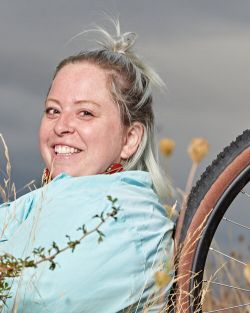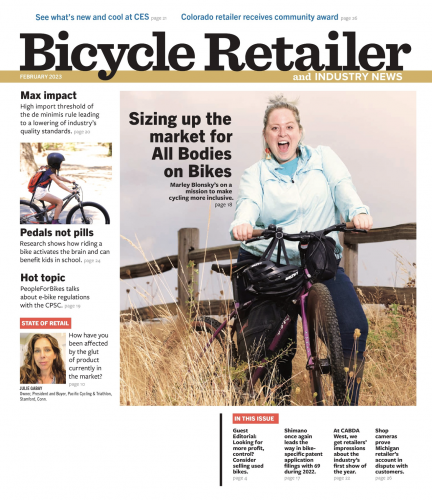A version of this article ran in the February issue of Bicycle Retailer and Industry News. Retailers can get the print or digital version of the magazine free — subscribe at this link.
While the industry strives to diversify its audience and product offerings to become more inclusive, Marley Blonsky and her organization All Bodies on Bikes are taking the lead to welcome and include riders of all sizes.
Let’s hear her story, then check in with retailers and suppliers who are making a difference.
BRAIN: How did you get introduced to cycling?
Blonsky: Like most kids in the early 1990s, my free time was spent on a bike. It wasn’t unusual for us to ride with a pack of 10 or 15 neighborhood kids for hours on end. That’s where my love of cycling truly started.
My first adult bike was a slightly-too-big Nishiki. While I loved that bike and the freedom it provided, I quickly realized it didn’t fit well. I upgraded to a Liv Avail, the most expensive thing I could imagine at nearly $600. I eventually added a rack and started bike camping and bikepacking.
Pretty soon after, I started breaking spokes and a seat post. After many frustrating attempts to fix the wheels, I realized that I probably needed a stronger, more durable bike for both my weight and the kind of riding I was doing.
Until the spring of 2020, I had never had a cycling kit that fit me. Everything was either too small or if it fit, it would inevitably be a men’s jersey. I didn’t feel cute or comfortable in the oversized shoulders and narrow waistbands.
BRAIN: What led you to start All Bodies on Bikes?

Blonsky: In 2018, I attended the Women Trans Femme Bikexplorer’s Summit in Whitefish, Montana. At this summit, nearly every conversation focused on diversity, equity, and inclusion — making cycling more accessible and inclusive for everyone, but especially for marginalized populations.
Around this same time, I ran across my co-founder, Kailey Kornhauser on Instagram. She was riding her bike across Alaska and lamenting the lack of a proper cycling rain jacket that fit her. We started scheming a way to bring the topic of size inclusion to a bigger audience.
In August of 2019, Kailey and I presented our first Size Inclusion Seminar to nearly 50 people. We were encouraged to continue to spread the word, so we applied to the League of American Bicyclists Summit in March 2020.
We started fundraising and through our GoFundMe, a reporter at The Washington Post reached out. She wrote an amazing article about us, which led to a filmmaker finding our story and getting Shimano to sponsor it, which led to the birth of All Bodies on Bikes.
BRAIN: How do equipment choices for larger people affect their cycling progress?
Blonsky: You can wear anything to ride a bike — jeans, leggings, dresses — they all work great. Until they don’t, which for me was 15 or 20-mile rides or more. When your body doesn’t fit into the gear that is provided, you feel like you are the problem.
There is also the concern about prohibitively low weight limits on bikes. Many bikes — especially performance-oriented road, gravel and mountain bikes — top out at 300 pounds. This simply isn’t high enough, especially when you consider the cargo that folks will likely be carrying.
Not having the clothing or equipment for larger people sends the message that this activity isn’t for us — even though cycling is absolutely amazing for all body types and sizes.
BRAIN: How has the growth of e-bikes affected accessibility for larger riders?
Blonsky: Depending on where you live, cycling can be hard! Especially as a bigger person — hills do not climb themselves. E-bikes have really taken away that barrier and made joyful movement a reality for lots of people who didn’t have it before.
I think the biggest downside has been the proliferation of cheap bikes that have scary-low weight limits. I see a lot of bigger people on folding e-bikes and it scares the crap out of me.
BRAIN: What’s your response to a product manager who says, "I'd love to make that 3XL jersey or that sturdier bike, and I don't think the demand is there to justify it."?
Blonsky: Work with me! We have a built-in audience of over 20,000 people — most are not being served by the current market and are actively looking for bigger clothing, stronger bikes and more inclusive groups.
I often hear that, “Oh we’ve tried it. They didn’t sell.” And to that I ask, “How did you let us know that your product exists? Did you market specifically to people in larger bodies?” If I go on your website and don’t see a body that looks like mine, I’ll assume that you don’t make my size.
BRAIN: Do you have any tips for retailers that can help them expand their appeal?
Blonsky: Use influencer marketing — and not necessarily just fast cyclists. Most of your customers are your average Jane and Joe just looking to have a good experience. I’m always amazed at how seriously people take my product recommendations.
Train your salespeople on how to talk sensitively about weight limits to customers. Don’t assume that larger-bodied people are riding to lose weight. We ride for the same reasons as everyone else — for a challenge, to train, for joy. Treat us like all the rest of your customers.
Have larger sizes to try on. It might not be economical to stock the full size range of all the products. But if you can have at least one of each size so people outside the average size range can try on, that goes a long way toward feeling included.
SUPPLIERS
Shimano sponsored the All Bodies on Bikes video that launched the movement toward wider worldwide recognition in 2021. “There is a lot that can be done to improve outreach to larger riders,” said Nick Legan, Shimano’s road brand manager.
“Having Kailey and Marley as Shimano ambassadors has helped us learn how to speak about the subject with sensitivity and understanding. I think it’s important that our marketing represents the entire cycling experience and Marley and Kailey help us do that.
“In terms of product, Shimano recently launched LINKGLIDE, a flat-bar drivetrain that prioritizes high durability. It’s great for e-bikes and for riders who find themselves wearing out drivetrain components more quickly than others.”
Worksman Cycles has been making industrial bikes and trikes since 1898. Their website now includes a “Bikes for Bigger People” page with 14 models pictured.
“We were swamped with orders from both retailers and consumers during the pandemic,” noted Worksman President Wayne Sosin. Worksman sells to about 100 U.S. shops, with 30% average gross margins and a five-bike opening order.
“We learned over the years that when people who are 300 pounds-plus want to be active, they have to ensure that the weight capacity is appropriate,” Sosin said. “Using the components we use on our industrial bikes, we have a lineup of consumer models that can really be put to the test.”
RETAILERS
Amanda Dobbs is co-owner of Camden Bicycles in Minneapolis. She describes the store as, “a one-of-a-kind bicycle shop that caters to marginalized folks. As we know, in this industry larger people are often left out.”
“I am a 6-foot tall woman who weighs 220ish, my husband is 6-foot, 6-inches and about 280 (pounds),” said Dobbs. “As lifelong cyclists, we’ve had nothing but trouble finding gear that fits. I purchase apparel from Fat Lad at the Back and we are the only U.S. shop to carry this British product. I have yet to find a U.S. brand that celebrates all body sizes as well.
“Things are slowly changing but the terminology hasn’t. A Clydesdale is a big fat horse, get that language out of there!” she exclaimed. “You could say ‘frames for larger bodies,’ or ‘bikes for all bodies big and small.’ I bet ‘Clydesdale’ was made up by some skinny white dude.”
Stephanie Bucalo from Bert’s Bikes and Fitness, with eight stores in the Buffalo area, finds that her 5-foot, 4-inch, 120-pound frame can be off-putting to bigger riders when she leads shop rides. “Every ride, someone will comment on my ‘traditional cyclist’ body type. That’s helped me think through how we work with all our clientele.”
“I talk with our salespeople about how to address questions about weight. People ask, ‘Will this bike hold up under me?’ Our approach is to mirror the language they use themselves to talk about their weight. Bigger, heavier, whatever they say, say it back to them.”
“I recently had a 300-pound customer wanting to buy an entry-level hybrid,” she recalled. “We changed to wider tires and increased the spoke count. The whole time I was saying, ‘This will make your ride more comfortable.’ Focus on benefits like comfort and durability, not the size of their body.”


